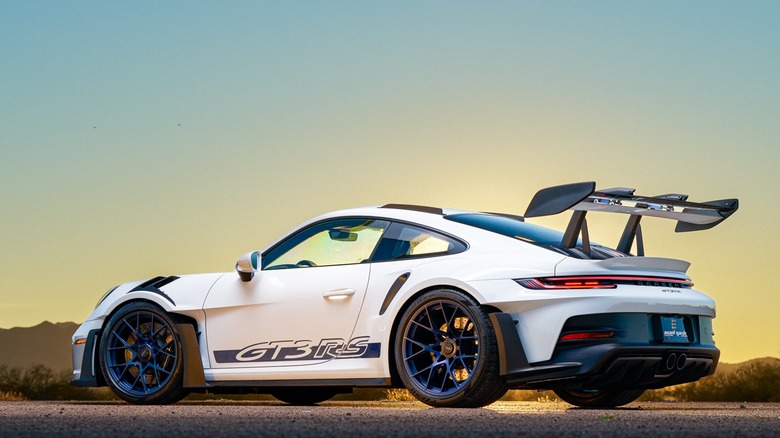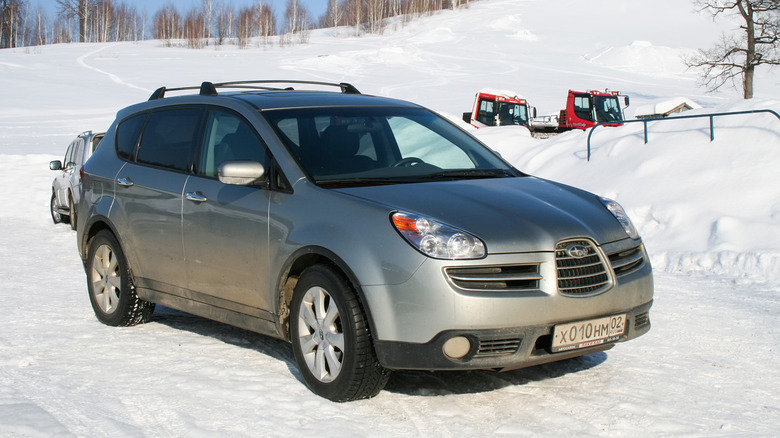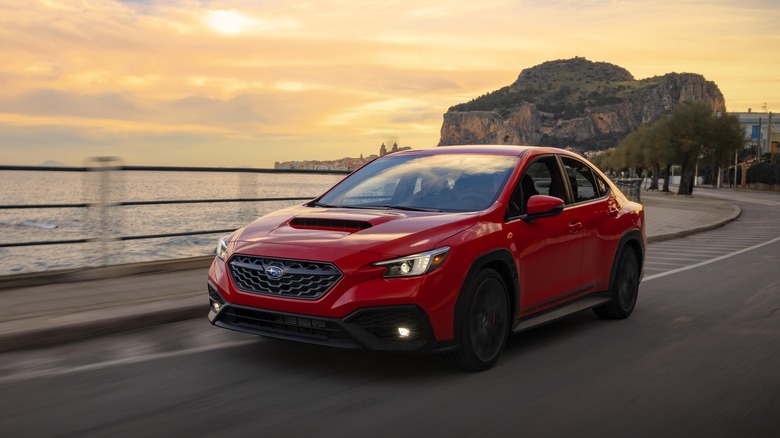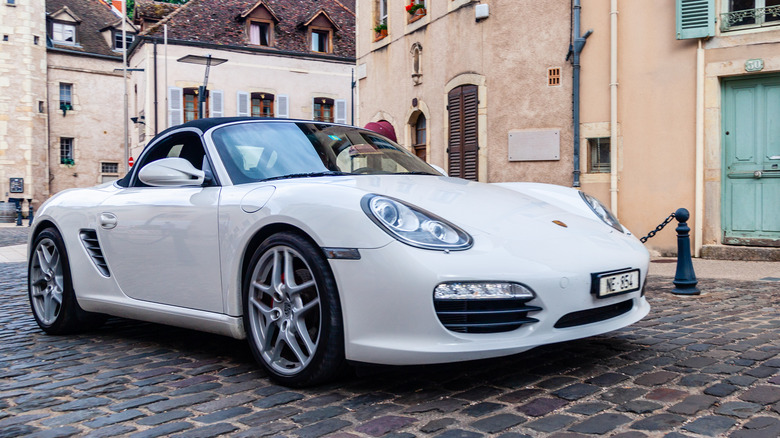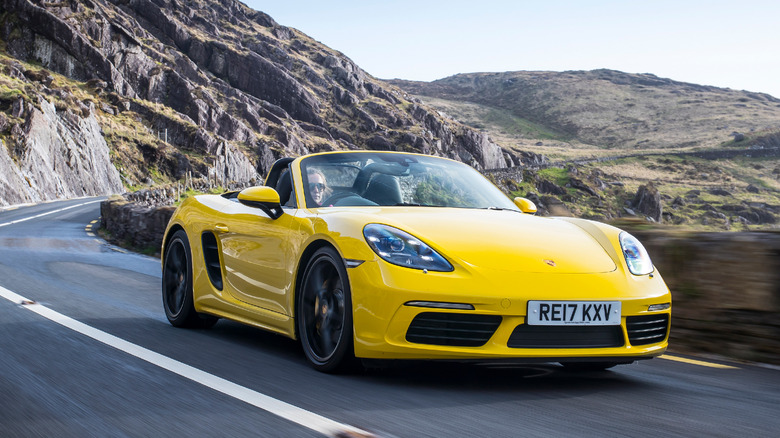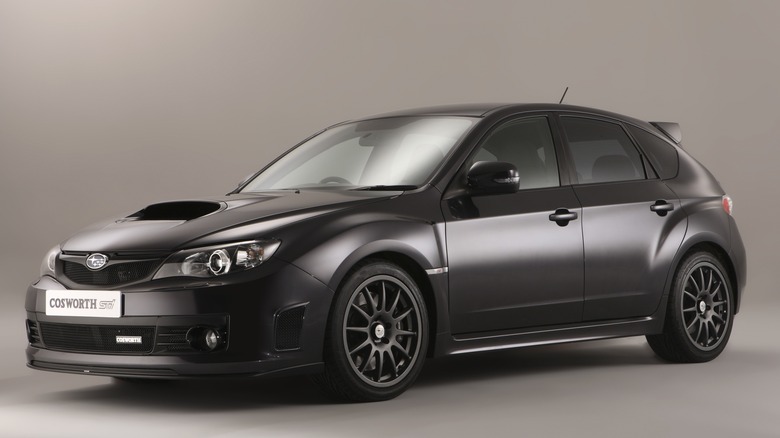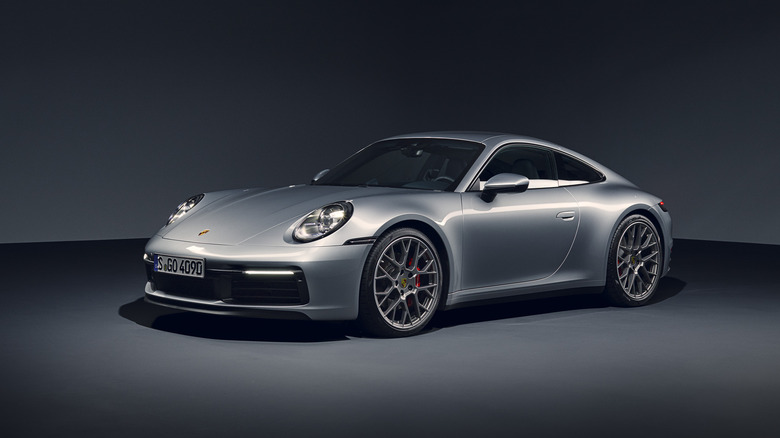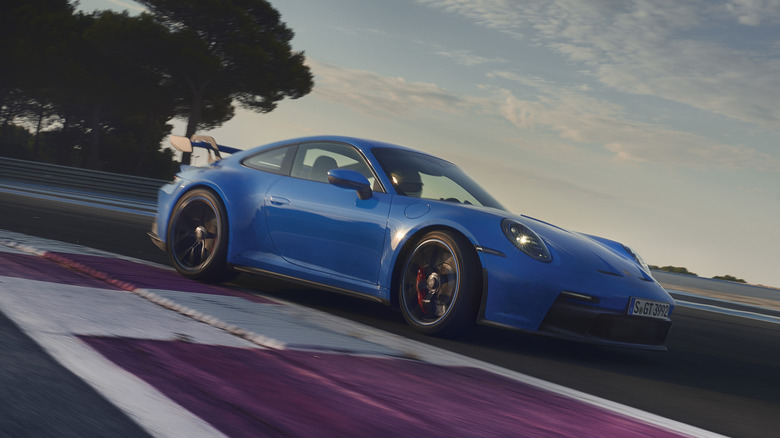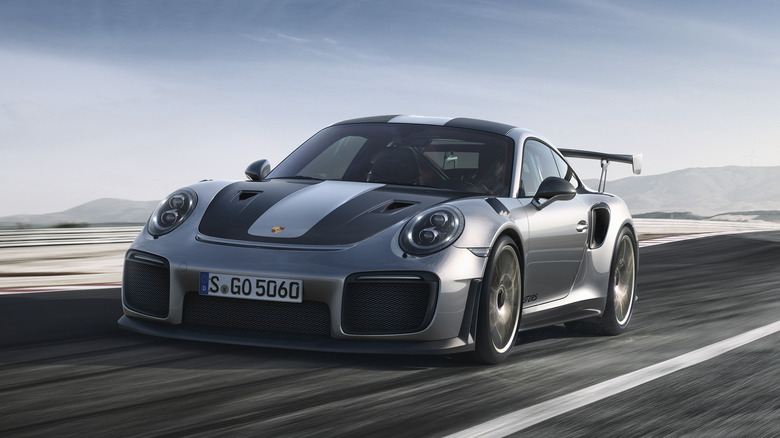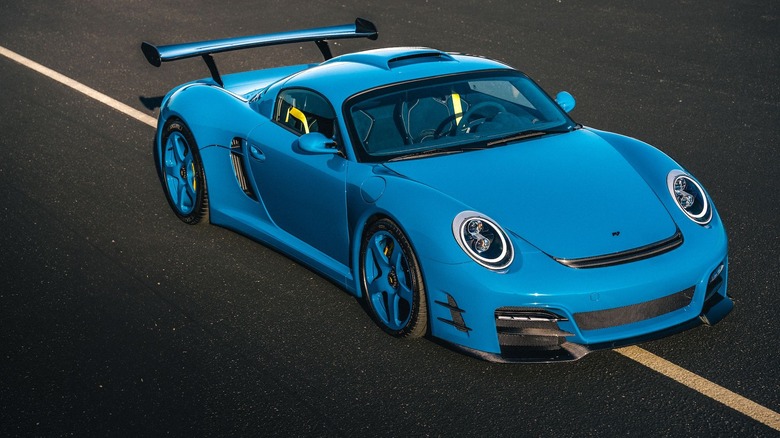10 Of The Most Powerful Boxer Engines Ever Made
Back in the 1960s, Subaru brought the boxer engine closer to mass market buyers, after Porsche put it into its very first sports cars. By this time, the automotive world existed mostly on inline and V layout engines, making the boxer a pretty substantial novelty. Instead of the cylinders completing the process of internal combustion vertically, they are mounted sideways, horizontally opposing each other. Thus, when the pistons are moving up and down, they look like they're boxing, which is where this innovative powertrain gets its name.
One of the most notable benefits of this layout is packaging, as mounting the engine horizontally allows it to take up a lot less vertical space in the engine bay. What's more, due to its better balance, the boxer engine vibrates a lot less, and it's capable of putting out more power due to the smaller load on the crankshaft. Not to mention, when done properly, it makes a fantastic noise.
As well as Subaru continuing to use the boxer in just about all of its models, Porsche also continued using the boxer layout in a few models you may or may not have heard of. Boxer engines have been pushed to their limits many times, resulting in some true powerhouses.
Subaru EZ36 - 256 hp
Subaru's signature trait is the boxer engine, and it's all that's used in most of their passenger vehicles. Most of them had, and still have, four cylinders, but Subaru also gave the six-cylinder boxer a try, just like you'd find on a Porsche. The EZ36 is easily the most well-known iteration of the boxer six from Subaru.
Powering stuff like the Legacy and Outback, both of them bearing the 3.6R badge, it also powered the ill-fated B9 Tribeca luxury SUV. With a DOHC design, and all-aluminum block and cylinder heads, the EZ36 put out a respectable 256 hp in stock form. The EZ36 has plenty of performance and instant responsiveness due to it being naturally-aspirated. Smoothness is also one of its strong suits, making it well-suited for luxury applications like the B9 Tribeca. Combining more than four cylinders with the already minimal vibrations that a boxer benefits from results in a properly smooth powertrain.
Subaru's six-cylinder engines are a lot less common than its four-bangers, and it's likely we'll never see another flat six from the automaker. It's a shame, because for a while, the only way to have a flat six without buying a Porsche was through Subaru.
Subaru FA24 - 271 hp
Even though the name of the game is electrification currently, Subaru hasn't forgotten about the enthusiasts, and especially their love for internal combustion and burning gasoline. Despite the declining compact performance car segment, you can still have a brand new Subaru WRX, complete with a turbocharged flat four and AWD. Although the WRX's styling has been the subject of a lot of controversy and debate, it's a solid experience behind the wheel, and it's good to see that we will have a flat four-powered compact car for a little while longer, at least.
The engine powering the new WRX is Subaru's FA24, which is very similar to what you might find under the hood of the Ascent SUV, as well as the most recent BRZ and Toyota GR86. The turbocharger gives it a pretty healthy output of 271 hp. As you might expect, there's a good amount of headroom for more power, despite the engine's all-aluminum design. It's just a tad bit unfortunate that the FA24 has been plagued with some serious reliability issues, so that's just something to consider.
Porsche 3.4L (987.2 Boxster/Cayman) - 295 hp
While Subaru has toyed around with the idea of a flat six powertrain, everyone knows that the number one proponent of boxer six-cylinders is definitely Porsche. The Porsche 911 has used a flat six since the very beginning, and then the Boxster and Cayman went onto receive similar powertrains as well.
It's hard to believe, but the original 986 Boxster that came out in the mid 90s had less than 250 hp, courtesy of a relatively small 2.7-liter flat six. Once the 987.2 Boxster and Cayman came along, the flat six was approaching and exceeding 300 hp, putting out a healthy 295 hp. Commonly known as the M97, the upgraded 3.4-liter flat six gave the Boxster and Cayman some proper performance, taking less than 5 seconds to reach 60 mph.
Unfortunately, having its roots in the 996 911 means that this engine can be prone to some IMS issues, but those can be sorted ahead of time and fairly easily. Being a Porsche feat of engineering, the M97 can also take a pretty good beating when it comes to extra horsepower.
Porsche 2.5L (718 Cayman and Boxster S) - 345 hp
It was definitely controversial when the news first broke, but for the fourth and current generation of the Porsche Boxster and Cayman, Porsche did the unthinkable: it eschewed the flat six power units and replaced them with smaller, friendlier (to the environment) flat fours. This separated them from the 911 lineup a fair bit, but it also meant that Porsche's entry level sports cars could carry on despite tightening emissions regulations.
Displacing 2.5 liters in the S variants, the little boxer four puts out 345 hp, which is plenty. It also manages to rev to 7,500 RPM, despite having a turbocharger, which is an impressive feat in its own right. It may not be the best-sounding engine on the market, but crucially, it hasn't meant the Cayman and Boxster have lost the magic that makes them so good to drive.
What's even more interesting is that the 2.5-liter, and the smaller 2.0-liter boxer four are very similar to the flat six you'd find in the back of the 911. The two powertrains share a lot of basic components, though the four-cylinder units are lighter, they use an air-to-liquid intercooler, and they're a little bit better on fuel.
Subaru 2.5L CS400 - 395 hp
There's only one possible way that car enthusiasts have even heard of the Subaru Impreza STI CS400, and that's with the 2012 remake of "Need for Speed: Most Wanted." But what even is the Impreza CS400? It's an ultra-limited run of the Subaru Impreza WRX STI based on the third generation Impreza, and it featured input from grandmasters of engineering Cosworth. It was RHD only, and it was only available in the UK.
As with any fast Impreza, power came from a turbocharged boxer four, specifically a 2.5-liter unit. Being the Cosworth special, of course, it didn't make anything close to 300 hp, but rather a pretty significant 395 hp.
Cosworth upgraded some choice components under the hood, resulting in a pretty monstrous hot hatchback ... if kept above 3,500 RPM, that is. There's also 400 lb-ft of torque on tap, which is pickup truck territory, and if the turbo is having a good day, the Impreza CS400 can blast to 60 mph in around four seconds or less.
Porsche 3.0L (Carrera S) - 444 hp
While Porsche has shown it can do boxer four cylinders very well, everyone knows that Stuttgart's engineers can truly let their hair down when the flat six is involved. From the very beginning in the 60s, all the way to the present day, the Porsche 911 has used a flat six engine, and that doesn't seem to be changing anytime soon.
The 991 generation used a 3.8-liter naturally-aspirated unit on the Carrera S models, but due to everyone's favorite emissions regulations, the current 992 had to go turbo. That meant more efficiency, but it also meant more power. The 3.0-liter twin-turbo unit in the current Carrera S dispatches a plentiful 444 hp.
Adding forced induction has also meant an increase in torque, but it's more impressive that the new Carrera S puts out just a little less power than the Turbo of 15 years ago. The 911 lineup is just as expansive and as confusing as ever, so it can be easy to forget how much you could do with 444 hp.
Porsche 4.0L (GT3) - 518 hp
It's the one engine that Porsche enthusiasts can't get enough of. A 4.0-liter naturally-aspirated flat six has been in service in Porsches, in one form or another, since the 997 GT3 RS. The reasons why everyone shivers with excitement when they hear its name are obvious: it's one of the last remaining naturally aspirated engines of any kind on the market, and it can rev to a screaming 9,000 rpm.
A boxer six-cylinder screaming away at 9,000 rpm is music to the ears. Of course, you can have the 4.0-liter with the 718 lineup nowadays, but for the optimal 4.0 experience, the 911 GT3 lineup has the hookups.
In the latest 992 GT3, the 4.0-liter flat six puts out 518 hp, which can propel the GT3 to 60 mph in less than 3.5 seconds. What's even more impressive than the engine's sound, or its race-derived hardware, the explanation for which is far too complicated, is that Porsche was able to make it comply with strict global emissions regulations, and that includes the even more stringent than most European regulations. That's what you call engineering.
Porsche 3.8 TT (911 GT2 RS) - 691 hp
Just when everyone thought the 911 couldn't get better, Porsche dropped this absolute bombshell back in 2017, during an event for Forza Motorsport 7. The cover car for that game ended up being the 911 GT2 RS, the absolute peak of the 991 lineup, and the end of the line for that generation of the rear-engined icon.
The performance figures that the GT2 RS managed to muster up were truly a sight to behold. Mounted on the rear axle was a twin-turbocharged 3.8-liter flat six putting out a colossal 691 hp. That's right, the factory 700 hp 911 finally became a thing. Those were numbers people expected from stuff like 9FF and RUF, but the GT2 RS made it possible in a conventional 911 that you could buy from Porsche itself. Well, theoretically.
Porsche used the 991 Turbo's engine as a base point, and in usual Porsche fashion, the GT2 RS' engine includes plenty of race-bred upgrades, including larger turbos, and an uprated crankshaft. Small wonder that this car set a 6 minute, 47 second lap time at the Nurburgring.
RUF 3.8L TT (CTR3 Evo) - 800 hp
So what happens when even the peak of the Porsche 911 lineup isn't quite powerful enough? Look no further than Porsche experts RUF. Most car enthusiasts of a certain age were made aware of RUF thanks to video game studios' loophole during Electronic Arts' exclusive Porsche licensing deal. RUF was the only way for other racing games to have Porsche, and RUF cars have become legends.
The absolute peak of the RUF lineup is the CTR3 Evo. Although it does use a few handpicked Porsche components, the bodywork and the chassis are both bespoke. The engine found under the bespoke bodywork is, perhaps unsurprisingly, something special.
It's a RUF-designed 3.8-liter twin-turbo flat six, with all sorts of bleeding edge hardware and complicated engineering work, which is all difficult to explain, but ensures that the CTR3 Evo can hold its own. That is, hold its own against just about any supercar. That performance is plentiful, with 800 hp and 730 lb-ft of torque, allowing the CTR3 Evo to reach an astronomical 236 mph.
